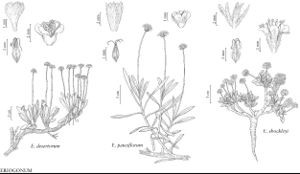Eriogonum shockleyi
Proc. Amer. Acad. Arts 18: 194. 1883.
Herbs, matted, scapose, 0.3–0.5 (–0.7) × (0.5–) 1–4 (–20) dm, floccose to tomentose, greenish or grayish. Stems matted, sometimes only seemingly so, with persistent leaf-bases, up to 1/5 height of plant; caudex stems matted; aerial flowering-stems absent or scapelike, erect or nearly so, slender, solid, not fistulose, (0.05–) 0.1–0.3 dm, floccose to tomentose. Leaves basal, fasciculate in terminal tufts; petiole 0.2–0.5 cm, tomentose to floccose; blade oblanceolate to elliptic or spatulate, (0.2–) 0.3–0.8 (–1.2) × 0.2–0.4 (–0.6) cm, tomentose to floccose, margins plane or slightly thickened. Inflorescences capitate, 0.8–2 cm; branches absent; bracts 3–5, scalelike, linear to linear-lanceolate, 1.5–4 × 0.6–1 mm. Peduncles absent. Involucres 2–4 (–6) per cluster, campanulate, (2–) 2.5–5 (–6) × 3–6 (–7) mm, rigid, tomentose; teeth 5–10, erect to spreading, (0.5–) 1–3 mm. Flowers 2.5–4 mm; perianth white to rose or yellow, densely pilose; tepals connate proximally, monomorphic, oblong to obovate; stamens exserted, 2.5–5 mm; filaments subglabrous or sparsely pilose proximally. Achenes light-brown to brown, 2.5–3 mm, tomentose.
Phenology: Flowering May–Aug.
Habitat: Gravelly or clayey (rarely sandy) flats, washes, and slopes, saltbush, blackbrush, and sagebrush communities, pinyon-juniper woodlands
Elevation: (800-)1200-2600 m
Distribution

Ariz., Calif., Colo., Idaho, Nev., N.Mex., Utah.
Discussion
Eriogonum shockleyi is widely distributed in northern Arizona, east-central California, western Colorado, southern Idaho, northwestern New Mexico, Nevada, and Utah. On the Colorado Plateau, it has oblanceolate to spatulate leaf blades usually 0.3–1.2 × 0.3–0.6 cm, scapes 1–3 cm, involucres with long (2–3.5 mm) often spreading teeth, and flowers 3–4 mm. These plants have been distinguished as var. longilobum. The typical Great Basin expression has elliptic leaf blades 0.3–0.6 × 0.3–0.5 cm, scapes 0.5–2 cm, involucres with short (0.5–2 mm) erect teeth, and flowers 2.5–4 mm. Low, compact, hummock-like plants in southwestern Idaho with elliptic leaf blades 0.1–0.3(–0.35) × 0.1–0.15 cm, flowering stems absent or up to 0.5 cm, and involucres 2.5–3 mm with teeth 0.8–1 mm have been termed var. packardiae. These morphologic differences have been shown to be genetically insignificant, however (J. F. Smith and T. A. Bateman 2002). Plants on moving sand dunes at the southeast end of Baking Power Flat in Lincoln County, Nevada, can be up to 2 m across. Further studies may indicate that the various geographic expressions deserve taxonomic recognition.
The Great Basin expression is the food plant of the Bernardino dotted-blue butterfly (Euphilotes bernardino). Members of the species are occasionally found in cultivation.
Selected References
Lower Taxa
"dm" is not declared as a valid unit of measurement for this property."dm" is not declared as a valid unit of measurement for this property."dm" is not declared as a valid unit of measurement for this property."dm" is not declared as a valid unit of measurement for this property.
